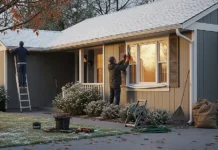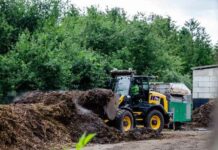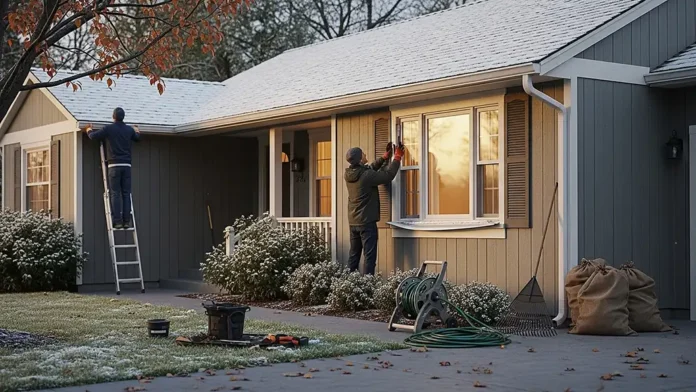Winter has a way of exposing every weak spot in a home—drafty windows, creaky heaters, and pipes that seem to freeze at the worst possible moment. Skipping even one maintenance task can mean big repair bills or safety risks. The only real defense? Getting ahead of the season with a plan that covers all the bases.
So, what’s actually in this guide? Not just a checklist. Expect a mix of the most important winter home maintenance tasks for 2025, how to shield pipes and roofs from trouble, the emergency supplies every household should have, and a few expert tips for saving energy (and avoiding the classic mistakes).
Winter Home Preparation Essentials
Inspect and Seal Windows and Doors
Drafts are sneaky. Even a tiny gap can let in enough cold air to make the heater work overtime. Sealing up leaks is one of the cheapest ways to boost comfort and cut bills—but it’s easy to miss the small stuff.
- Run a hand along window and door frames on a windy day to spot drafts.
- Weatherstripping works for moving parts; caulk is for cracks and gaps.
- Old windows? Window insulation film or thermal curtains can help, but don’t expect miracles.
- Basement windows and attic hatches are often forgotten—until the cold finds them.
And yet, even after all that, some homes still feel drafty. Go figure.
Service Heating Systems and Chimneys
A heater that quits in January? No one wants that. Annual maintenance keeps things running and can catch problems before they turn into emergencies.
- Book a pro to check the furnace, boiler, or heat pump. Filters need swapping monthly in heavy use.
- Fireplaces and wood stoves? Chimneys need cleaning and a look for creosote or blockages.
- Test the thermostat—consider a smart upgrade for more control.
- For tight spaces, a Murphy cabinet bed can turn an office into a cozy spot without eating up floor space.
Still, even the best-maintained system can surprise you. That’s winter for you.
Check and Upgrade Insulation
Insulation is the unsung hero of winter prep. Too little, and heat escapes fast—especially in older homes.
- Inspect attic, basement, and crawl space insulation. Bare joists or patchy spots mean it’s time to add more.
- Foam pipe insulation is a must for exposed plumbing in cold areas.
- Energy-efficient windows or storm windows can help, but sometimes the payback takes a while.
And yet, some homes still lose heat faster than expected. Sometimes, it’s just the way the house was built.
Protect Plumbing and Pipes
Frozen pipes are a classic winter disaster—expensive, messy, and usually preventable.
- Insulate pipes in basements, garages, and crawl spaces.
- Drain and shut off outdoor faucets and irrigation. Styrofoam covers help if you can’t shut off the line.
- Keep the thermostat above 55°F, even when away.
- Know where the main water shutoff is—just in case.
But even with all this, pipes can still freeze in a freak cold snap. That’s winter in a nutshell.
Clean Gutters and Inspect Roof
Gutters and roofs take a beating in winter. Ignore them, and you might be dealing with leaks or ice dams.
- Clear out leaves, twigs, and debris. Make sure water flows away from the house.
- Check for missing or damaged shingles, and look at flashing around chimneys and vents.
- Get repairs done before the first snow—winter only makes problems worse.
Still, even a spotless gutter can clog if a storm dumps enough debris.
Prepare Outdoor Spaces and Equipment
Outdoor prep is easy to skip—until a storm hits and the damage is done.
- Prune branches over the house, driveway, or power lines. Weak limbs snap under snow and ice.
- Store or cover patio furniture, grills, and tools. Drain fuel from gas-powered gear.
- Mark garden beds and walkways with snow poles for easier snow removal.
- Stock up on ice melt, sand, and shovels before the first storm.
But sometimes, even the best prep can’t stop a surprise freeze.
Emergency and Safety Readiness
Stock Up on Supplies and Emergency Kits
Winter storms can knock out power and make roads impassable. Having supplies on hand is more than just smart—it’s essential.
- Build a kit with non-perishable food, water, flashlights, batteries, and a first-aid kit.
- Don’t forget extra blankets, medications, and pet supplies.
- Store important documents in something waterproof.
- If anyone relies on medical devices, a backup power source or generator is worth considering.
Still, even the best-stocked kit can run low if a storm drags on.
Smoke and Carbon Monoxide Detector Checks
Heating systems and fireplaces mean more risk of fire or carbon monoxide. Regular checks are non-negotiable.
- Test smoke and CO detectors monthly. Swap batteries at the start of the season.
- Put detectors on every floor, especially near bedrooms and fuel-burning appliances.
- Keep fire extinguishers handy and check their pressure.
But even with all this, accidents can happen. That’s why redundancy matters.
Power Outage and Backup Plans
Losing power in winter isn’t just inconvenient—it can be dangerous. Having a plan is half the battle.
- Portable generators can keep essentials running, but only if used safely (carbon monoxide is no joke).
- Keep flashlights, lanterns, and batteries where they’re easy to grab.
- Have a backup heat source such as a 3 zone mini split, wood stove, or another off-grid option that works effectively.
Still, sometimes the outage lasts longer than anyone expects.
Energy Efficiency and Cost Savings
Conduct a Home Energy Audit
Energy audits can reveal where heat is leaking out and where upgrades will pay off. But not every fix is cheap—or quick.
- Many utilities offer free or low-cost audits. Book one before winter for tailored advice.
- Upgrades might include insulation, duct sealing, or a new heating system.
- Savings can range from 5–30% on bills, but results vary.
And sometimes, the audit just confirms what you already suspected.
Programmable Thermostats and Smart Home Tech
Smart thermostats are everywhere now, promising lower bills and more comfort. But only if they’re set up right.
- Programmable thermostats let you set heating schedules to match your life.
- Smart models can learn habits and adjust automatically—some claim up to 15% savings.
- Zoned heating, like a 3-zone minisplit, lets you control temps in different rooms.
But even the smartest tech can’t fix a drafty house.
Special Considerations for 2025
New Trends and Technologies
Winter 2025 isn’t just about old-school prep. New products and tech are changing the game.
- Solar-powered mini split systems are gaining traction for backup or off-grid heat.
- Energy-efficient windows, storm doors, and advanced insulation materials are everywhere.
- Smart home monitors can spot leaks, track temps, and send alerts before things go wrong.
But with every new gadget comes a learning curve—and sometimes, a few bugs.
Temporary Spaces and Flexible Living
Major repairs or renovations can mean finding new places to sleep. In tight homes, a Murphy cabinet bed is a clever way to add a guest room or flexible sleeping spot without losing everyday space.
But even the best solutions can feel cramped during a long winter.
Comparison Table: Key Winter Prep Tasks
It’s easy to get lost in the details, but not all winter prep tasks are created equal. The table below claims to sort out the essentials—cost, time, impact, and the classic mistakes. But does it really capture the headaches of a burst pipe or a drafty window at 2 a.m.? Maybe. Maybe not. Real life tends to throw in a few surprises.
| Task | Cost Range | Time Required | Impact on Comfort & Safety | Common Mistake to Avoid |
| Insulate Attic & Pipes | $100–$1,500 | 2–8 hours | Major heat retention, prevents burst pipes | Skipping unheated areas |
| Service Heating System | $80–$300 | 1–2 hours | Reliable, efficient heating | Not replacing filters or skipping annual check |
| Clean Gutters & Downspouts | $0–$250 | 1–3 hours | Prevents ice dams, water damage | Leaving debris or loose attachments |
| Seal Windows & Doors | $20–$200 | 1–4 hours | Reduces drafts, saves energy | Missing small gaps or using wrong materials |
| Roof & Chimney Inspection | $150–$500 | 2–4 hours | Stops leaks, fire hazards | Ignoring minor damage or creosote |
| Prep Outdoor Faucets | $0–$50 | 30 min | Prevents pipe bursts | Not draining lines fully |
| Stock Emergency Supplies | $50–$300 | 1–2 hours | Safety during outages | Forgetting batteries or medications |
| Upgrade Thermostat/Tech | $100–$500+ | 1–2 hours | Energy savings, remote control | Not programming or using features |
| Prune Trees & Outdoor Care | $0–$400 | 2–6 hours | Prevents storm damage | Leaving weak limbs or tools outside |
But even the best-laid plans can unravel if a single step gets skipped. Who hasn’t forgotten a hose outside, only to regret it later?
Stay Warm, Safe, and Ready for Winter 2025
Winter prep isn’t just a checklist—it’s a way to buy peace of mind. Every step, from sealing drafts to upgrading thermostats, helps keep the cold out and the comfort in. But no plan is foolproof. Sometimes, the season throws a curveball.
Key takeaways? Insulate, seal, and maintain to dodge heat loss and big repairs. Service heating and safety devices before the first cold snap. Try new tech—smart thermostats, solar-powered mini splits, and 3-zone minisplits can boost efficiency and resilience.
A little effort now means fewer headaches when the snow starts falling. But will it be enough for whatever winter 2025 brings? Only time will tell.
FAQs
What are the 5 P’s of winter weather?
The 5 P’s—Protect People, Pets, Plants, Pipes, and Practice Fire Safety—cover the basics. But even with all five, winter sometimes finds a sixth “P”: “Prepare for Surprises.”
How do I make sure my house is ready for winter?
Inspect insulation, seal up windows and doors, service the heating system, clean gutters, and stock up on emergency supplies. Don’t forget to test smoke and CO detectors. But even then, something unexpected can pop up.
How do I prepare my house for freeze warnings?
Insulate pipes, seal leaks, drain outdoor faucets, and keep the thermostat above 55°F. Know where the water shutoff is. Still, a sudden cold snap can catch anyone off guard.





























